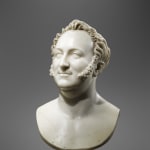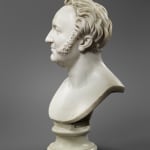José Álvarez Cubero (Spanish 1768 – 1827)
White marble on circular marble base
Further images
Circa 1819 Àlvarez Cubero sculpted his first bust of Rossini for the Infante Sebastián Gabriel de Borbón y Braganza (1811-1875). This bust, now in the Museo del Prado (fig. 1), carries the name of the sitter at the back, together with the signature of the sculptor, a very unusual feat for Àlvarez Cubero.
CLICK HERE TO DOWNLOAD THE PDF
The present and hence second bust was known to exist (Sanchez 2011, 172-173; Azcue 2011, 331 ff.), but has only recently been rediscovered in a private collection in Germany. It is almost identical to the one at the Prado Museum and was executed by Àlvarez Cubero for his Maecenas, Carlos Miguel Fitz-James Stuart y Silva, the 14th Duke of Alba (1794-1835, cf. Sanchez 2011, 172 ff.).
After the sudden death of Àlvarez Cubero some of his works made for the Duke of Alba were brought from his studio in Rome to Spain. A document dated 6th August 1828 in the archives of the Duke mentions a marble bust of Rossini together with a corresponding plaster: "pertenecientes al S.r Duque de Berwik: Una Venus con un amorcito sacandola una Espina; Un Busto que representa al Maestro de Musica Rossini; Otro de igual representacion en Yeso; Una Estatua que representa la Marquesa de Ariza difunta".[1]
[1] Translation: "belonging to the Duke of Berwick: A Venus with an angel removing a thorn; A Bust that represents the Master of Music Rossini; Another one of equal representation in gesso; A Statue representing the deceased Marquise of Ariza". SeeAzcue 2011, 331 ff.
However, when the 14th Duke died in 1835, the inventory and catalogue of the works acquired by him fail to mention a marble bust and only refer to the plaster bust of Rossini. A subsequent inventory from 1870 also only mentions the plaster version. This plaster is most probably the one currently held at the Museo de la Real Academia de San Fernando (fig. 3.).[1]
Thus, somewhere between 1828 and 1835 the marble bust of Rossini made by Àlvarez Cubero for the Duke of Alba's collection must have changed hands. One plausible possibility is that this marble portrait was actually handed over by the Duke in 1831 to Rossini.
The Duke was a fond admirer of the illustrious composer from Pesaro and they became close friends after having met each other on several occasions, as shown in the Duke's diaries. They met for the first time in 1814 when Rossini and his future wife, the Madrilenian mezzo-soprano Isabel Angela Colbrán (1784-1845), were presented to the Duke at a party at the Bolognese salon of Madame Martinetti. They met again for a second time in 1816 in Naples, where Colbrán had meanwhile become the diva of the San Carlo Theatre and Rossini its leading composer. In 1821 the Duke even stayed for certain while at the residence of Colbrán in Bologna on his way to Paris (Sanchez 2011, 172-173).
The library of the Palacio de Liria, the Madrid residence of the Dukes of Alba, holds several autographs of Rossini's works and printed works complete with friendly dedications to the Duke. Their relationship was so close that in 1820, through his wife, Rossini even lent an enormous amount of money to the Duke, who was constantly spending huge sums on innumerous works of art for his extraordinary collection. In the archives of the Liria Palace there's a letter in immaculate Spanish, dated 17th February 1831, in which the composer friendly reminds the Duke of his outstanding debt of 16,000 ducats together with all due interests.[2]
Later in 1831 Rossini visited the Duke in Madrid mainly in order to settle the outstanding debt. According to a very plausible hypothesis by Leticia Azcue Brea, head curator of sculpture of the Museo del Prado, the bust was given to Rossini as a compensatory gift on that occasion. In the 20th century, it resurfaced in a private collection in Germany.
[1] Azcue 2011, p. 333
[2] "V.E., please do not forget that on September 2, 1820, Mrs. Isabel Colbrán, my wife, made a loan to [you, the] V. E., of 16,000 ducats of Naples at the interest [rate] of that kingdom and in the manner and form that the laws there prescribe. This capital, the fruit of our efforts, was entrusted to you […] for the particular friendship and affection that you have always showed me… ", cf. Barreiro Lastra, H., Presencia de Rossini en Madrid: febrero de 1831. Antecedentes y derivanciones, unpubl. doctoral thesis, Madrid 2006.
Provenance
Commissioned by the 14th Duke of Alba, Carlos Miguel Fitz-James Stuart and delivered before 1828
Likely to have been given to Rossini on his visit to Madrid in 1831
Private Collection Germany, acquired in the 1980s
Art Loss Register: S00148478
Literature
'José Àlvarez de Pereira y Cubero, escultor', Museo universal, 30 July 1857.
Augé, Jean-Louis, Les élèves espagnols de David, Acl-Crocus, Saint Sebastien, 1989.
Azcue Brea, Leticia, "José Álvarez Cubero". La escultura en la Real Academia de Bellas Artes de San Fernando, Real Academia de Bellas Artes de San Fernando, Madrid, 1994.
Azcue Brea, Leticia, 'Catalogo de esculturas modernas. Retrato de Benoît-Guillaume-Ange Poublon (tradicionalmente identificado como "Gioachino Rossini'')', in: Beatrice Cacciotti (Ed.) El xiv Duque de Alba coleccionista y mecenas de arte antiguo y moderno. Consejo Superior de Investigaciones Científicas, Madrid, 2011.
Azcue Brea, Leticia, 'El origen de las colecciones de escultura del Museo del Prado. El Real Museo de Pintura y Escultura', in El taller europeo. Intercambios, influjos y préstamos en escultura moderna europea. I Encuentro europeo de museos con colecciones de escultura, Valladolid, 2012.
Azcue Brea, Leticia, 'I contatti di Bartolini con la Spagna e il Portogallo', in Lorenzo Bartolini, scultore del bello naturale, Giunti Editore, Firenze, 2011.
Azcue Brea, Leticia, 'Roma y la Escultura del s. XIX en el Museo del Prado. La odisea de los pensionados hasta 1873', in El taller europeo. Intercambios, influjos y préstamos en escultura moderna europea. I Encuentro europeo de museos con colecciones de escultura, Valladolid, 2012.
Burke, M. (2003, January 01). Alba, Duques de family. Grove Art Online.
Cacciotti, Beatrice. El xiv Duque de Alba coleccionista y mecenas de arte antiguo y moderno. Consejo Superior de Investigaciones Científicas, Madrid, 2011.
Duque de Alba, Discursos leídos ante la real Academia de Bellas Artes de San Fernando en la recepción pública del Excmo. Sr. Duque de Berwick y de Alba, Madrid 1924.
Fernández López, R., José Álvarez Cubero, figura cumbre de una saga de alarifes, escultores (José Álvarez Bouquel) y arquitectos (Aníbal Álvarez Bouquel, Manuel Aníbal Álvarez Amoroso y Ramón Aníbal Álvarez y García de Baeza), Ayuntamiento de Priego de Córdoba, Priego de Córdoba, 2011.
García, W., & Movellán, A. (2003, January 01). Àlvarez family. Grove Art Online.
Gaya Nuño, J.A. Arte del siglo XIX, A. Hisp., 19 (Madrid, 1966).
Gossett, P. (2001, January 01). Rossini, Gioachino. Grove Music Online.
Museo Nacional del Prado, El siglo XIX en el Prado, Museo Nacional del Prado, Madrid, 2010.
Ossorio y Bernard, M. Galería biográfica de artistas españoles del siglo XIX (Madrid, 1883-4).
Pardo Canalís, E, Escultores del siglo XIX (Madrid, 1951).
Salas, Xavier de, Museo del Prado: adquisiciones de 1969 a 1977, Patronato Nacional de Museos, Madrid, 1978. (= De Salas 1978)
Sánchez, Jorge García. 'Los círculos artísticos y la colección de pintura y de escultura moderna.' in: Beatrice Cacciotti (Ed.) El xiv Duque de Alba coleccionista y mecenas de arte antiguo y moderno. Consejo Superior de Investigaciones Científicas, Madrid, 2011. (= Sanchez 2011)
Zueras Torrens, F., José Àlvarez Cubero (Priego, 1986).






